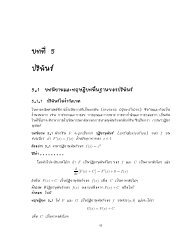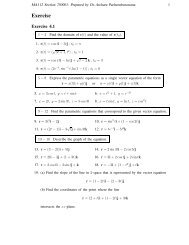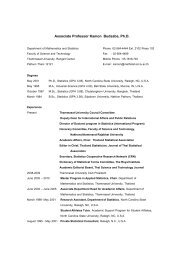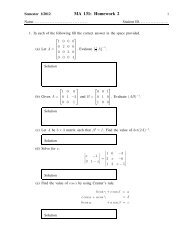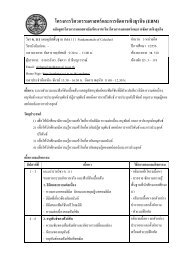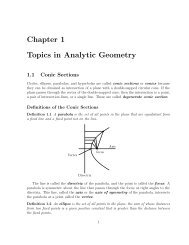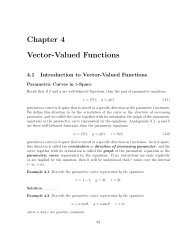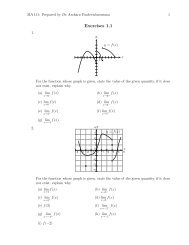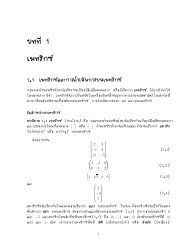Chapter 1 Topics in Analytic Geometry
Chapter 1 Topics in Analytic Geometry
Chapter 1 Topics in Analytic Geometry
Create successful ePaper yourself
Turn your PDF publications into a flip-book with our unique Google optimized e-Paper software.
MA112 Section 750001: Prepared by Dr.Archara Pacheenburawana 192.2 Polar Coord<strong>in</strong>atesPolar Coord<strong>in</strong>ate SystemsA polar coord<strong>in</strong>ate system <strong>in</strong> a plane consists of a fixed po<strong>in</strong>t O, called the pole (ororig<strong>in</strong>), and a ray emanat<strong>in</strong>g from a pole, called the polar axis. In such a coord<strong>in</strong>atesystem we can associate with each po<strong>in</strong>t P <strong>in</strong> the plane a pair of polar coord<strong>in</strong>ates (r,θ),where r is the distance from P to the pole and θ is an angle from the polar axis to the rayOP.P(r,θ)rθO Orig<strong>in</strong>Polar axisThe number r is called the radial distance of P and the number θ the angular coord<strong>in</strong>ate(or polar angle) of P.Example 2.9 Plot the po<strong>in</strong>ts whose polar coord<strong>in</strong>ates are given.(a) (3,π/4) (b) (4,2π/3) (c) (2,5π/4) (d) (4,11π/6)Solution .........The polar coord<strong>in</strong>ates of a po<strong>in</strong>t are not unique. For example, the polar coord<strong>in</strong>atesall represent the same po<strong>in</strong>t.5π/3(1, 5π 3 ) −π/3(1,5π/3), (1,−π/3), (1,11π/3)(1,− π 3 ) 11π/3In general, if a po<strong>in</strong>t P has polar coord<strong>in</strong>ates (r,θ), then(r,θ +2nπ) and(r,θ −2nπ),(1, 11π3 )are also polar coord<strong>in</strong>ates of P for any nonnegative <strong>in</strong>teger n.As def<strong>in</strong>e above, the radial coord<strong>in</strong>ate r of a po<strong>in</strong>t P is nonnegative, s<strong>in</strong>ce it representsthe distance from P to the pole. However, it will be convenient to allow for negativevalues of r as well. To motivate an appropriate def<strong>in</strong>ition, consider the po<strong>in</strong>t P with polarcoord<strong>in</strong>ates (3,5π/4). We can reach this po<strong>in</strong>t by



